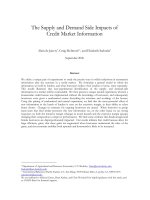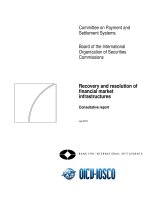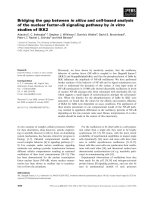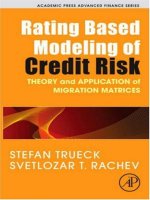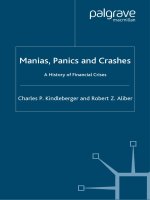Econophysics and agent based modeling of financial market
Bạn đang xem bản rút gọn của tài liệu. Xem và tải ngay bản đầy đủ của tài liệu tại đây (6.32 MB, 162 trang )
Econophysics and Agent-Based Modeling of
Financial Market
FENG LING
NATIONAL UNIVERSITY OF SINGAPORE
2013
Econophysics and Agent-Based Modeling of
Financial Market
FENG LING
(B.Sc.(Hons), National University of Singapore)
A THESIS SUBMITTED
FOR THE DEGREE OF DOCTOR OF PHILOSOPHY
NUS GRADUATE SCHOOL FOR INTEGRATIVE
SCIENCES AND ENGINEERING
NATIONAL UNIVERSITY OF SINGAPORE
2013Acknowledgements
Many people have contributed to this dissertation in different ways, and it is my
esteemed pleasure to thank them, without whom the thesis could never been pos-
sible.
First and foremost, I would like to express my greatest gratitude to my Ph.D su-
pervisor professor Li Baowen for his invaluable supervision, guidance and patience.
It has been a privilege to be his Ph.D student, and I am extremely thankful for
his inspiring discussions, and sharing of knowledge. At the same time, I have to
thank the academic freedom and independence he gave me to think and explore
an exciting territory of highly interdisciplinary research area between physics and
economics. His enthusiasm and insight have motivated me throughout the whole
course my Ph.D studies.
I would also like to thank my Thesis Advisory Committee (TAC) members pro-
fessor Gong Jiangbin, professor Joseph Cherian and professor Chen Ying, for their
valuable advices and critical comments on my research project. Since they come
from different departments, it has not been easy for them to communicate and
coordinate as my advisory committee. But they have spent their valuable time
i
and effort in making this possible.
I am extremely grateful to Professor H. Eugene Stanley from Boston University, for
being a very helpful collaborator and caring mentor. The time I have spent in his
group at Boston gave me a great deal of exposure to the frontiers in this research
area. His insight and guidance are the most rewarding experience to me during
that period, not to mention his hospitality and warm-heartedness as a personal
friend who made that part of my life a rather unforgettable experience.
My thesis would also be in no part possible without the help of my collaborator
professor Boris Podobnik, who has also been a very pleasant friend and mentor,
providing me with insightful perspective on the work as well as a broader picture
on how to carry out high quality research. Professor Tobias Preis has also been
a valuable collaborator and friend who helped me along the way, with his expert
opinions and techniques.
Special thanks go to my group members and friends Liu Sha, Zhang Xun, Zhu
Guimei, Yang Lina, Ren Jie, Ma Jing and Qiao Zhi for sharing the joys and pains
with me. Their company during my candidature played an irreplaceable part of
life. I also thank professor Yang Huijie for his insightful discussions during the
early stage of my candidature.
Finally, my upmost appreciation goes to my beloved parents, who provide their
unconditional love and support in every aspects of my life.
ii
Table of Contents
Acknowledgements i
Summary vii
Publications x
List of Tables xi
List of Figures xii
1 Introduction 1
1.1 Stylized facts in financial time series . . . . . . . . . . . . . . . . . 3
1.1.1 Absence of autocorrelation in returns . . . . . . . . . . . . . 5
1.1.2 Power-law probability distribution of large returns . . . . . . 7
1.1.3 Long memory of absolute and squared returns . . . . . . . . 8
1.1.4 Memory in trade signs . . . . . . . . . . . . . . . . . . . . . 11
1.1.5 Power-law distribution of trading volume, size and number
of trades . . . . . . . . . . . . . . . . . . . . . . . . . . . . . 12
1.1.6 Other stylized facts . . . . . . . . . . . . . . . . . . . . . . . 13
1.2 Agent-based models . . . . . . . . . . . . . . . . . . . . . . . . . . . 15
iii
1.2.1 Heterogeneous agent-based model (1999) . . . . . . . . . . . 16
1.2.2 Herding (percolation) model (2000) . . . . . . . . . . . . . . 19
1.2.3 Threshold updating model (2007) . . . . . . . . . . . . . . . 22
1.2.4 Model of order book dynamics (2008) . . . . . . . . . . . . . 23
1.3 Summary on existing literature . . . . . . . . . . . . . . . . . . . . 25
2 Data and Methods 28
2.1 Data . . . . . . . . . . . . . . . . . . . . . . . . . . . . . . . . . . . 29
2.1.1 Stock holdings by Institutional owners . . . . . . . . . . . . 30
2.1.2 Transaction data of US stocks . . . . . . . . . . . . . . . . . 31
2.2 Methodologies . . . . . . . . . . . . . . . . . . . . . . . . . . . . . . 32
2.2.1 Autoregressive conditional heterokedasticity models (ARCH) 32
2.2.2 Tail exponent and Hill estimator . . . . . . . . . . . . . . . 34
2.2.3 Monte Carlo simulation . . . . . . . . . . . . . . . . . . . . 35
2.2.4 Programming languages . . . . . . . . . . . . . . . . . . . . 36
3 Empirical Data Analysis 38
3.1 Returns of different frequencies . . . . . . . . . . . . . . . . . . . . 39
3.2 Tail exponents of trade-by-trade returns . . . . . . . . . . . . . . . 42
3.3 Review of empirical data . . . . . . . . . . . . . . . . . . . . . . . . 45
4 Agent-Based Model of Opinion Convergence by Technical Traders 48
4.1 Market ecology . . . . . . . . . . . . . . . . . . . . . . . . . . . . . 49
4.1.1 Fundamentalists and technical traders . . . . . . . . . . . . 49
4.1.2 Volume turnover . . . . . . . . . . . . . . . . . . . . . . . . 50
4.1.3 Trading volume contribution . . . . . . . . . . . . . . . . . . 51
iv
4.2 Empirical and theoretical agent behaviors . . . . . . . . . . . . . . 53
4.3 Model construction . . . . . . . . . . . . . . . . . . . . . . . . . . . 59
4.4 Model justification and parameter determination . . . . . . . . . . . 61
4.4.1 Rationale for each step . . . . . . . . . . . . . . . . . . . . . 61
4.4.2 Determination of parameters . . . . . . . . . . . . . . . . . . 63
4.5 Simulation results and analysis . . . . . . . . . . . . . . . . . . . . 66
4.5.1 Different values of V
f
. . . . . . . . . . . . . . . . . . . . . . 67
4.5.2 Different values of n
0
. . . . . . . . . . . . . . . . . . . . . . 68
4.5.3 Different agent size distribution . . . . . . . . . . . . . . . . 69
4.5.4 Different values of b . . . . . . . . . . . . . . . . . . . . . . . 70
4.6 Extrapolation to intraday returns . . . . . . . . . . . . . . . . . . . 72
4.7 Summary on agent-based model . . . . . . . . . . . . . . . . . . . . 77
5 Stochastic Volatility Model 78
5.1 Mathematical analysis of ABM . . . . . . . . . . . . . . . . . . . . 79
5.1.1 ARCH type model . . . . . . . . . . . . . . . . . . . . . . . 79
5.1.2 Excess kurtosis . . . . . . . . . . . . . . . . . . . . . . . . . 81
5.2 Heterogenous investment horizons . . . . . . . . . . . . . . . . . . . 82
5.3 Stochastic volatility model . . . . . . . . . . . . . . . . . . . . . . . 86
5.3.1 Heterogenous investment horizons in opinion convergence . . 86
5.3.2 Impact on trading activity . . . . . . . . . . . . . . . . . . . 89
5.3.3 Final stochastic volatility model . . . . . . . . . . . . . . . . 90
5.4 Scaling relations of long memory . . . . . . . . . . . . . . . . . . . 92
5.5 Monte Carlo simulation . . . . . . . . . . . . . . . . . . . . . . . . . 97
5.5.1 Determination of parameters . . . . . . . . . . . . . . . . . . 97
v
5.5.2 Results . . . . . . . . . . . . . . . . . . . . . . . . . . . . . . 99
5.5.3 Robustness checking . . . . . . . . . . . . . . . . . . . . . . 103
5.6 Long memory and self-similarity . . . . . . . . . . . . . . . . . . . . 105
5.7 Summary on the stochastic volatility model . . . . . . . . . . . . . 110
6 Relationship to ARCH Models 111
6.1 Conditional volatility . . . . . . . . . . . . . . . . . . . . . . . . . . 112
6.2 Fitting onto GARCH . . . . . . . . . . . . . . . . . . . . . . . . . . 113
6.3 Fractionally integrated processes . . . . . . . . . . . . . . . . . . . . 116
6.4 Heterogeneous ARCH . . . . . . . . . . . . . . . . . . . . . . . . . . 118
6.5 Borlan-Bouchaud . . . . . . . . . . . . . . . . . . . . . . . . . . . . 121
6.6 Quadratic ARCH . . . . . . . . . . . . . . . . . . . . . . . . . . . . 123
6.7 Non-quadratic dependence . . . . . . . . . . . . . . . . . . . . . . . 127
6.8 Short summary . . . . . . . . . . . . . . . . . . . . . . . . . . . . . 128
7 Conclusion 130
Bibliography 134
vi
Summary
Econophysics is an interdisciplinary research area where physicists apply their
thinkings and methods to economics. The field is motivated by extensive empirical
observations made available through the growing volume of economic data. This
study focuses on one particular aspect of econophysics - agent-based modeling of
financial market. There are a number of universal patterns found in financial time
series called ‘stylized facts’; among them are fat-tail distributions and long memory
in volatilities. These patterns cannot be explained by the theory of rational agents
or efficient market hypothesis. Additionally, the market agents interact with each
other to give rich phenomena including social learning and herding. Hence in the
past decades, there has been a growing trend of simulating the financial market
based on the interactions of agents with different behavioral rules, and such models
are called agent-based models.
Empirical evidence indicates that technical traders dominate trading activity with
shorter holding period compared to fundamental investors. Hence daily price fluc-
tuations are influenced much more by technical traders. Empirical and theoretical
evidence suggests that agents tend to have similar opinions after large price fluctu-
ations, and diverged opinions after tranquil market conditions. Such a mechanism
vii
can be incorporated into an agent-based model to simulation price dynamics. With
a realistic set of parameters, the model produces power-law tail distribution in re-
turns with numerical accuracy, and the result is found to be robust with different
parameter values. In addition, the model is able to capture the power-law tail
distribution in daily number of trades at the same time, signifying a sound mech-
anism underlying the model. By incorporating the intraday seasonality in trading
volumes, extension of the model to intraday returns produces several empirical
statistical patterns at high frequencies.
Theoretical analysis on the agent-based model is carried out in line with Autore-
gressive Conditional Heteroskedasticity (ARCH) model formulation. With the ad-
ditional empirical evidence showing heterogeneous investment horizons of agents,
an extended stochastic volatility model is derived and it is able to produce long
memory of volatility found in financial time series, with quantitative accuracy.
Mathematical analysis leads to a scaling relation between the heterogeneity of in-
vestment horizons and decay speed of volatility. The analysis provides a behavioral
interpretation of the long-term memory of absolute and squared price returns: they
are directly linked to the way investors evaluate their investments by applying tech-
nical strategies at different investment horizons, and this quantitative relationship
is found to be in agreement with empirical findings.
By drawing an analogy to phase transition in physics, one-to-one correspondence
between financial market and statistical mechanics is made, and the long-range
correlation in time scale directly gives rise to the apparent critical phenomenon
in financial market. Comparing the stochastic volatility model with other ARCH
family models, this work gives an explicit interpretation to the general formulation
viii
of ARCH models in terms of agent behaviors, and provides a new avenue for
calibrating parameters based on empirical behaviors rather than statistical fitting.
ix
Publications
1. Ling Feng, Baowen Li, Boris Podobnik, Tobias Preis, and H. Eugene Stanley,
Linking agent-based models and stochastic models of financial markets. Proceed-
ings of the National Academy of Sciences, 109(22):83888393, 2012.
2. Zeyu Zheng, Boris Podobnik, Ling Feng, Baowen Li, Changes in Cross-Correlations
as an Indicator for Systemic Risk, Scientific Reports 2, Article number: 888, 2012.
x
List of Tables
4.1 Trading velocities of fundamentalists and technical traders . . . . . 64
4.2 Tail exponents from simulation with different values of V
f
. . . . . . 68
4.3 Tail exponents from simulation with different values of n
0
. . . . . . 69
4.4 Tail exponents from simulation with different values of b . . . . . . 71
4.5 Tail exponents of returns without intraday trading patterns . . . . . 76
5.1 Analogy between phase transition and financial time series . . . . . 106
xi
List of Figures
1.1 Autocorrelation of S&P500 daily price returns . . . . . . . . . . . . 6
1.2 Autocorrelation of S&P500 absolute and squared returns . . . . . . 10
1.3 Heterogeneous agent model . . . . . . . . . . . . . . . . . . . . . . 18
1.4 Percolation in networks . . . . . . . . . . . . . . . . . . . . . . . . . 20
2.1 Percentage of outstanding shares held by institutional owners . . . . 31
3.1 Cumulative distributions of high frequency returns . . . . . . . . . . 40
3.2 Tail exponents for distributions at different frequencies . . . . . . . 42
3.3 Trend in tail exponents for distributions on trade-by-trade returns . 43
3.4 Tail exponents for distributions on trade-by-trade returns . . . . . . 44
3.5 Tail exponents for day/night/daily returns . . . . . . . . . . . . . . 45
4.1 Average volume turnover . . . . . . . . . . . . . . . . . . . . . . . . 52
4.2 Ecology of stock market . . . . . . . . . . . . . . . . . . . . . . . . 53
4.3 Evolutionary strategies . . . . . . . . . . . . . . . . . . . . . . . . . 57
4.4 Empirical price impact function . . . . . . . . . . . . . . . . . . . . 62
4.5 Comparison between simulation results and empirical data . . . . . 67
4.6 CDF of returns with different values of V
f
. . . . . . . . . . . . . . 68
xii
4.7 CDF of returns with different values of n
0
. . . . . . . . . . . . . . 69
4.8 CDF of returns with different agent size distribution . . . . . . . . . 70
4.9 CDF of returns with different values of b . . . . . . . . . . . . . . . 71
4.10 Intraday trading seasonality . . . . . . . . . . . . . . . . . . . . . . 73
4.11 High frequency return distributions . . . . . . . . . . . . . . . . . . 75
4.12 CDF of returns without intraday seasonality . . . . . . . . . . . . . 76
5.1 Survey result on the use of strategies at different forecasting horizons 84
5.2 Usage of technical strategies at different investment horizons . . . . 88
5.3 Confirmation of the scaling relations in long memory . . . . . . . . 96
5.4 Comparison between the CDF of our stochastic volatility model and
S&P500 . . . . . . . . . . . . . . . . . . . . . . . . . . . . . . . . . 101
5.5 Comparison between the ACF of our stochastic volatility model and
S&P500 . . . . . . . . . . . . . . . . . . . . . . . . . . . . . . . . . 102
5.6 Simulation results using η
t
with different degrees of freedom . . . . 104
5.7 CDF of time series of different return intervals . . . . . . . . . . . . 108
5.8 Simulation and empirical returns for different return intervals τ . . 109
6.1 Comparison with GARCH(1,1) . . . . . . . . . . . . . . . . . . . . 115
6.2 Simulation of 5 components model . . . . . . . . . . . . . . . . . . 126
xiii
Chapter 1
Introduction
The term econophysics refers a relatively new discipline that aims to deal with
economic systems using the thinkings and approachs from physics. While it is still
arguable what exactly the definition of econophysics is, the way physicists deal with
such a complex system of economics has definitely provided some new perspectives.
While economic theories usually assume rational market participants (agents) with
certain utility functions, new evidence points out the fact of abundant irrational
behaviors among them. Additionally, the agents interact with each other to give
rich phenomena including social learning and herding, as opposed to the idea of
‘representative agents’ who only look at price and utility. The complexity of such
interactions has not been paid much attention until recently. Physicists have a long
history of dealing with large number of interacting particles in the field of statistical
mechanics. Although it is a little far-stretched to say human beings can be treated
as mechanical particles in physical systems, it does not negate some meaningful
1
Chapter 1. Introduction
contribution from physicists in the field of economics, and such endeavor is called
agent-based modeling.
This study only focuses on the study of financial market, which is possibly the most
studied among all areas of econophysics, due to the availability of large amount of
financial data at high frequencies in the recent decades and the market’s essential
role in modern economy. This field has been motivated by various empirical facts
found empirically in financial time series throughout the past decades, first of
which are fat-tail and volatility clustering by B. Mandelbrot in 1963 [1]. In the
past two decades, due to the availability of large amount of financial data, more
statistical facts were discovered in greater detail. H. E. Stanley has found power-
law tails in the distribution of returns [2], trading volumes and number of trades [3].
Such power-law tails follow largely invariant tail exponents across different markets
in the world. In statistical mechanics, similar universality phenomenon exists in
phase transition, and through renormalization theory such universality has been
successfully explained in terms of the interaction among particles regardless of the
size of interaction strength. This led physicists to wonder if there is a dominant
interaction mechanism underlying market dynamics that give rise to those universal
power-law exponents. Similar to particles, agents do interact with each other in
market with certain behaviors traits. If we model market based on interacting
agents, the models are named agent-based models.
In this work, agent behaviors are gathered through empirical evidence and theo-
retical intuition, and an agent-based model of financial market is constructed. The
mathematical analysis of the model is carried out using ARCH [4] formulation,
and extension is made to give a stochastic volatility model empirically calibrated
2
Chapter 1. Introduction
from market data. This thesis is presented in seven chapters. In this chapter, an
overview is presented on the existing empirical and theoretical studies. Chapter
2 describes the data and methods used in this study, and Chapter 3 presents the
result of some empirical data analysis. Chapter 4 describes a new agent-based
model (ABM) of financial market, with some investigation on empirical behaviors
based on market data. Chapter 5 extends the ABM to a stochastic time series
model with additional empirical behaviors, and a detailed study into this new
stochastic volatility model is presented. Chapter 6 draws relation between our
stochastic volatility model and existing models, and presents a variation of our
model. Chapter 7 concludes the whole study and proposes further work.
1.1 Stylized facts in financial time series
Among all the economic time series, financial time series is possibly the most com-
prehensively documented. This allows academic community to carry out thorough
investigations on financial markets. Many universal features in financial time series
have been discovered over the years, starting with Mandelbrot’s discovery on com-
modity price patterns [1] in 1963. In the recent years some new universal patterns
related to scaling properties have been discovered [5–7], and have been confirmed
across different financial markets [8–11].
Before presenting the various stylized facts of financial time series, some basic
quantities are defined first.
Asset price S
t
3
Chapter 1. Introduction
The price of an asset at time t can refer to the transaction price of a stock of a
company like IBM, or a commodity like cotton or gold. Exchange rate can also
be considered as a price and it shares many similar stylized facts with stocks and
commodities. Some studies use slightly different definitions of price (as in some
cases [12], quote price is incorporated to analyze price changes), but we stick to
the most conventional definition of transaction price.
Return r
t
When specifying return, a time interval τ must be specified as a parameter. It
refers to the proportional changes in the prices before and after time τ. τ can
be chosen to be from 1 minute to a few months. In this study we use log return
as it is most frequently used in other literatures due to its additive nature, and
under most circumstances (when price change is not too big) it is equivalent to raw
returns. Let s
t
denote the log value of price S
t
, i.e. s
t
= ln S
t
, the mathematical
definition of return is
r
t
= ln(S
t
/S
t−τ
) = s
t
− s
t−τ
(1.1)
Trading Volume V
t
Volume is defined as the total amount of asset being traded during the time interval
τ. In terms of stocks it is simply the number of shares changed hands during that
time. There are studies using traded value which is the total traded dollar value
within a time interval τ. These two definitions are largely the same given no
significant change in price. For each trade i within the time interval t −τ to t, the
4
Chapter 1. Introduction
number of shares traded is q
i
. Here we define the trading volume at time t is
V
t
=
t−τ<i≤t
q
i
(1.2)
Sometimes the number of transactions is used instead of real time as time scale.
There is merits for both choices of time scales, yet for simplicity we only use real
time scale in our analysis.
Number of trades N
t
The number of trades at time t simply refers to the total number of transactions
during a time interval τ.
1.1.1 Absence of autocorrelation in returns
It is widely accepted that prediction of price changes is almost impossible at a
meaningful time scale. This is in line with efficient market hypothesis (EMH), as
the market is efficient at arbitraging the correlations in returns when they appear,
until no more correlations exist for market participants to exploit. Mathematically,
the extend of predictability in stock market can be measured by autocorrelation
function (ACF) of return r
t
:
l
=
(r
t+l
− µ)(r
t
− µ)
σ
2
, (1.3)
where ······ refers to the average, µ is the mean value of returns µ = r
t
, and
σ
2
is the variance of reutnrs σ
2
= (r
t
−µ)
2
. If price at time t is uncorrelated with
5
Chapter 1. Introduction
price at a later time t + l for any value of l, it means there is no predictability on
returns, and
l
= 0.
The fact that
l
≈ 0 for any l larger than a few minutes has been verified by many
different studies. Figure 1.1 gives a graphical representation of this empirical fact.
0 10 20 30 40 50
-0.10 -0.05 0.00 0.05 0.10
time lag in days
Autocorrelation
ACF of SP500 daily returns
Figure 1.1: Autocorrelation of S&P500 daily price returns. The dotted line marks
the noise level. The ACF of all lags are around noise level, signifying a lack of
significant memory in daily returns.
6
Chapter 1. Introduction
1.1.2 Power-law probability distribution of large returns
The probability distribution of returns has received immense attention by aca-
demics and practitioners alike, as it gives the most straight forward representation
of market fluctuations. Discovery of fat tail or excess kurtosis in return distri-
butions can be tracked back to 1963, again in Mandelbrot’s paper [1]. In simple
words, fat tail means there is a significantly higher probability of large returns
than Gaussian distribution. It was later accepted that return distribution follows
a power-law at the tail region, meaning a straight line on log-log plot. Mathe-
matically speaking, this means the cumulative distribution function has the form
of P (r > x) ∼ x
−ξ
r
when x is big – typically a few times the size of standard
deviation σ. Here ξ
r
is called the tail exponent of return distributions. The fact
that whether the value of ξ
r
has a universal value across different financial markets
is still being debated, but it has been well accepted that its value is larger than 2,
which means the distribution is outside Levy stable distribution as hypothesized
in earlier literatures [5]. A tail exponent larger than 2 also means the variance -
second moment - is finite. Some results indicate that the fourth moment of return
statistics is finite, inferring a value of ξ
r
larger than 4, yet others [13] show the
contrary. Certain studies [14] argue that there might not be any universal value
for ξ
r
as it differs from asset to asset. The differences in opinion is possibly due to
different methods in estimating the tail exponents, as well as the range of empirical
data used in analysis.
The power-law tail has been repeatedly found in different markets during different
periods on stocks or stock indices. When the sample size is large - in the order of
7
Chapter 1. Introduction
millions - the tail exponents ξ
r
of high frequency data has often been found to be
close to 3 [2]. Similar results have been found in other markets including France,
UK [8, 9], Japan, [10] and India [11], but criticism [15] were directed at such
results for their lack of robust estimators used in evaluating the tail exponents.
Such criticism arised as physicists mostly used graphical fitting to conclude the
power-law tail nature of statistics, without rigorous statistical testing.
A reliable method for statistically estimating the tail exponent ξ
r
is to use Hill
estimator and its various implementations. We will discuss this method in detail
in Chapter 2 as it is the one we use to carry out empirical analysis. While this thesis
does not assert any universal value on the tail exponent ξ
r
, empirically retrieved
ξ
r
values are used to verify our models and theories, and ξ
r
≈ 4 has been found.
1.1.3 Long memory of absolute and squared returns
Despite the apparently erratic nature of price fluctuations, the size of price fluctua-
tions tend to remember their own pasts. In other words, big price changes (without
regards to the sign of the changes) tend to be followed by big changes and small
changes tend to be followed by small changes. Mathematically speaking, it means
the auto-correlation of absolute returns (or squared returns) decays slowly with
time lag l, and remains significantly above zero with l value up to a few weeks or
even months.
8
Chapter 1. Introduction
The autocorrelation of absolute returns is defined similarly to 1.3:
ρ
l
=
(|r
t+l
| −µ
|r|
)(|r
t
| −µ
|r|
)
σ
2
|r|
, (1.4)
with µ
|r|
= |r
t
| as the mean of absolute returns, and σ
2
|r|
= (|r
t
| − µ
|r|
)
2
is the
variance of absolute returns.
The autocorrelation of squared returns can be defined in the similar way:
ρ
l
=
(r
2
t+l
− µ
r
2
)(r
2
t
− µ
r
2
)
σ
2
r
2
, (1.5)
with µ
r
2
= r
2
t
as the mean of squared returns, and σ
2
r
2
= (r
2
t
− µ
r
2
)
2
is the
variance of squared returns.
The slow decay of autocorrelation with increasing time lag l has been well docu-
mented with high frequency returns as well [16–18], with the value of l being on
the scale of seconds to minutes. It must be noted that the existence of autocorre-
lation in absolute returns does not contradict with that of returns, as the earlier
does not involve the sign of r
t
. Figure 1.2 provides an graphic representation of
this fact. This means while it is hard to profit from predicting price returns, it is
possible to predict with some precision on the size of price fluctuations. This leads
one to suspect that the lack of autocorrelation in return itself is due to the lack of
memory in the sign of returns, which is related to the memory in trade signs ( +
for buy trades and − for sell trades). As we will see in the following section this is
actually not the case - trade signs do have some autocorrelations.
One additional remark has to be made here regarding the use of autocorrelation
9

